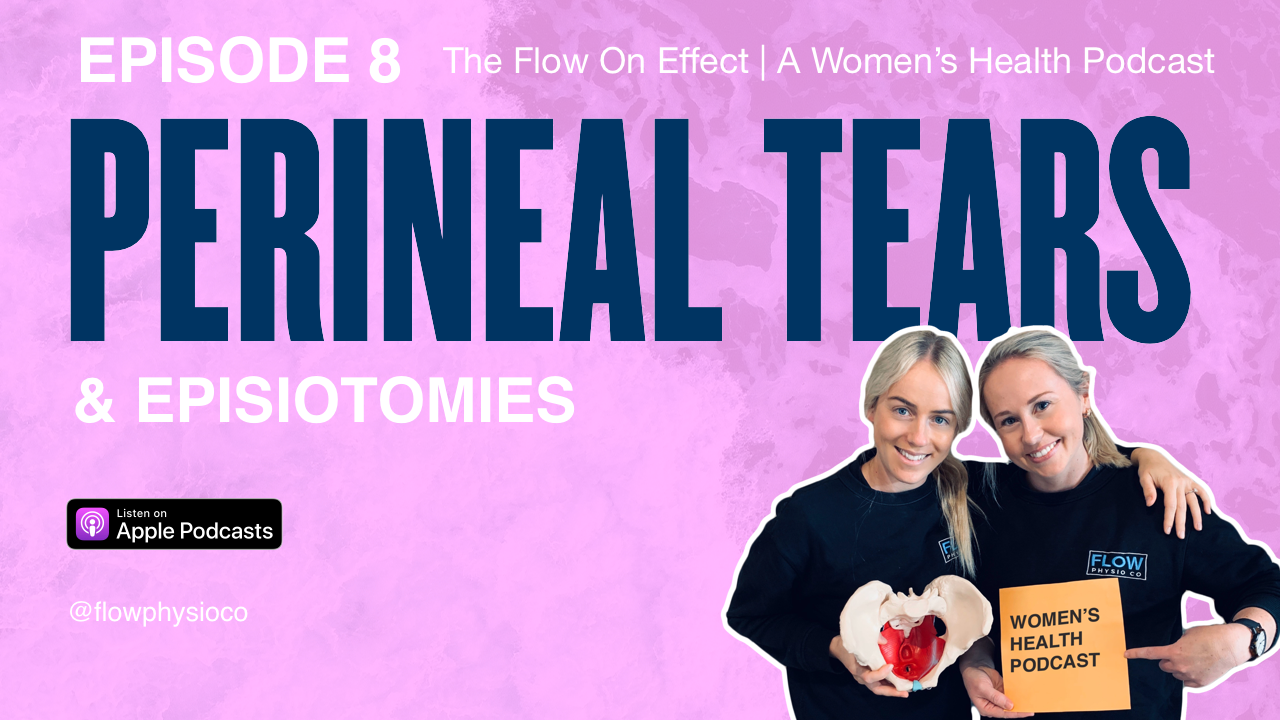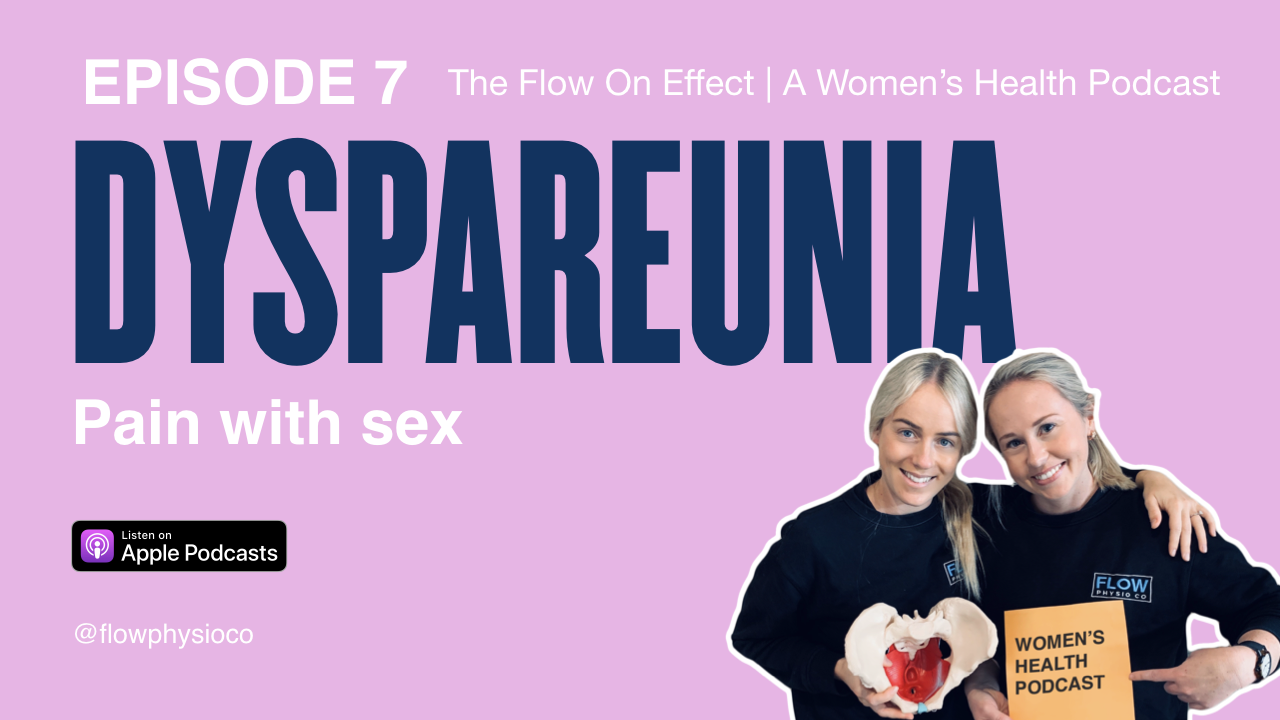Perineal tears and episiotomies
PODCAST EPISODE #08
CHARLOTTE CONLON AND HEIDI BARLOW ARE WOMEN’S HEALTH PHYSIOTHERAPISTS FROM FLOW PHYSIO CO, BASED IN THE SUTHERLAND SHIRE.
In today’s episode Charlotte and Heidi talk through perineal tears and episiotomies.
What is the perineum and what causes it to tear?
The perineum is the area between the vagina and the anus.
Tears are generally sustained in childbirth.
9/10 first time mothers will experience some sort of perineum tear following childbirth - Grade 1 and 2 tears are the most common, it’s the nasty grade 3 and 4 tears we are aiming to prevent.
What are the different degrees of tearing?
1st degree - a tear of the perineum skin
2nd degree - tearing of the perineum skin and into the pelvic floor muscle
3 a - <50% external anal sphincter torn
3 b - >50% external anal sphincter torn
3 c - external and internal sphincters are torn
4th degree - tear through entire epithelium
Who stitches these up, what is the process here?
1st and 2nd degree tears are generally stitched up in the delivery suite by Dr/Obs.
3rd and 4th degree tears require you to be taken to theatres after birth to be stitched up by a team of gyno/colorectal surgeons.
What are the risk factors for tearing?
According the the Royal Australian and New Zealand College of Obstetricians and Gynaecologists:
First delivery
Asian ethnicity
VBAC (Vaginal birth after C-Section)
<20 years old
Shortened perineal body length of less than 25mm (we measure this in the clinic)
Baby bigger than 4kg
Shoulder dystocia
Posterior position of bub
Instrumental delivery (forceps, vacuum)
Prolonged pushing stage in labour > 60 mins
Epidural use
Delivery in deep squatting position
Midline episiotomy
What is an episiotomy and how is this different to a tear ?
An episiotomy is where the Dr will make the decision to cut the perineum usually off to the side. It is usually done if they need to get the baby out in a hurry, if they are using instruments that need to fit in the vagina such as forceps or if they think you are likely to suffer a nasty tear.. Often healing is a little more painful with this.
Can you have both a tear and episiotomy ?
Unfortunately, yes. It is not very common but it does happen as you can tear in a different place to where the episiotomy is done.
Can anything else tear?
Yes, anything in the vulva area can tear.
The labia is also a common place to tear.
What do you do in the early days postpartum if you have a tear or episiotomy?
Manage bowels (fluid, diet, laxatives, stool softeners) - no straining, wait for natural urge
Supporting the area when defecating
Ice 10 mins on 10 mins off
Wear comfortable maternity pads that do not irritate the area such as TOMS organic brand
Keep the area clean
Does this management differ between the grades of tears?
3rd and 4th degree tears need more specific care, likely the surgeons will tell you not to use toilet paper and to use a spray bottle and dab clean instead.
What is the follow up care on tears?
Everyone should have a follow up after birth, no matter whether you tear or not.
Generally if you have a 3rd or 4th degree tear you will get a referral to a physio in the hospital and also have endoanal scans at 6 months to track how it is healing. You will also have follow ups with both your GP/obstetrician and colorectal surgeons.
When should women see a pelvic floor physiotherapist?
The general rule is at around 6 weeks post partum, after seeing your GP/Obstetrician. This is when we can perform an internal vaginal or rectal examination to check your pelvic floor muscles. However, we can still see women before this time if they are having any issues or concerns.
Do tears/episiotomies have long term issues ?
Generally, no, but some can. The main complaint is of pain or increased sensitivity along the scar. Pain with intercourse can also be an issue as the partner hits the sensitive scar tissue.
Is there anything that can help with the pain ?
We teach women scar tissue massage that women can start from 6 weeks to try and desensitise the area.
Therapeutic ultrasound and TENS can also help to reduce the scar tissue sensitivity and pain in the area.
Sometimes the area can become really dry and sore due to low Oestrogen while breastfeeding and if this is the case, your GP can prescribe an Oestrogen cream that can be applied to the area to help with this.
Is the management different for 3rd/4th degree tears ?
The initial management is much the same in the initial weeks after birth. However, because the anal schincters are involved, some women experience fecal urgency, they have have the inability to hold wind in or a feeling that wind escapes without their control, and they may experience fecal incontinence. At one year follow up 20-40% of women with these 3rd and 4th degree tears have fecal and wind incontinence.
Why does this fecal urgency and incontinence happen?
Our internal anal sphincter which is made of smooth muscle which we have no active control over, is responsible for 70% of our rectal control when there is a stool inside.
Our external anal sphincter which is made of skeletal muscle which we can voluntarily contract, is responsible for 30% of control.
Therefore, if there is damage to the external sphincter muscles we can lose up to 30% of our ability to control our bowels. That’s why pelvic floor exercises are crucial.
When should women start pelvic floor exercises?
Straight away! Once you have emptied your bladder for the first time after giving birth, light gentle squeezes can help with reducing swelling and gaining the connection back to the pelvic floor.
Does having a tear affect future deliveries?
For 1st and 2nd degree tears and episiotomies, there is generally no implication provided the recovery has been fine and they are not experiencing any long term issues.
For 3rd and 4th degree tears, the advice normally is not to give birth vaginally again. However, if it is something you really want, normally your care team can try and accommodate.
What can we do to prevent tearing and episiotomy ?
Perform perineal massage starting from 36 weeks in pregnancy
Use of the Epi-No device - an alternative to doing perineal massage is using a device to help stretch the entrance.
Ensure the pelvic floor muscles are able to relax well
Use a wet washer for heat compression inbetween contractions/pushing in labour
Maintain mobile hips in pregnancy
Trying to avoid giving birth in a deep squat position
Thank you for listening!
Thanks for joining us for this episode. We’d love to hear if you have any questions or feedback! Let us know in the comments section below.
If you enjoy listening to this podcast, please share or leave a review for us. We’d love to know what you think.
Materials and information shared are for educational purposes only.




